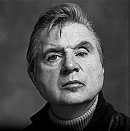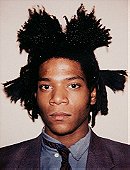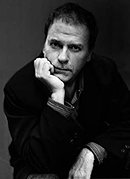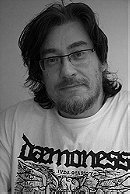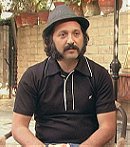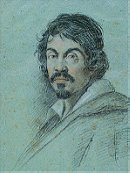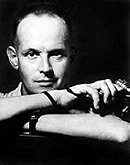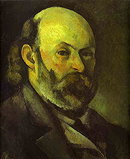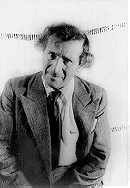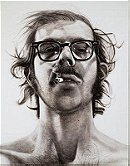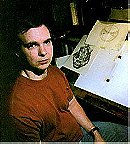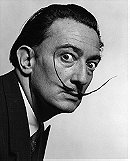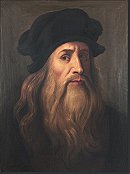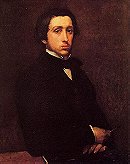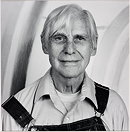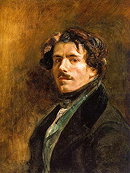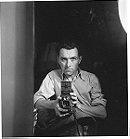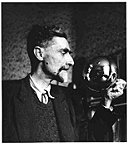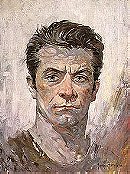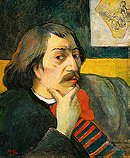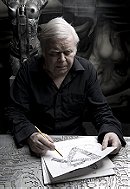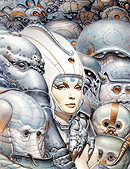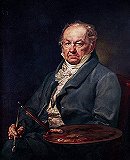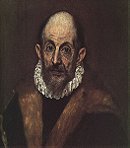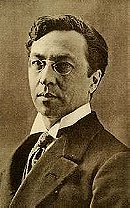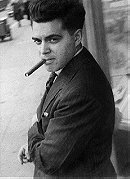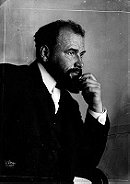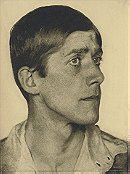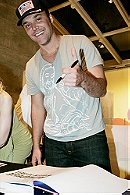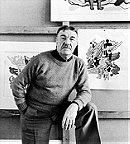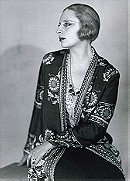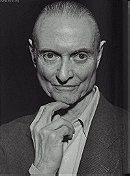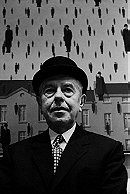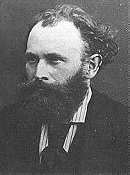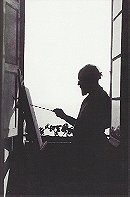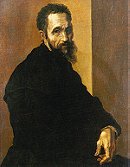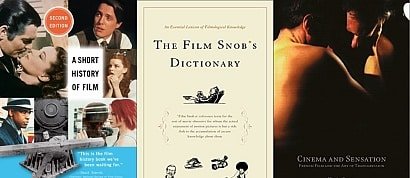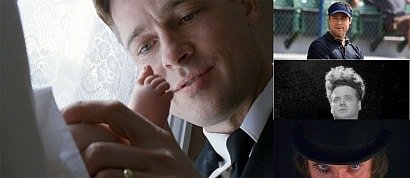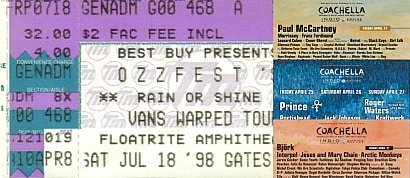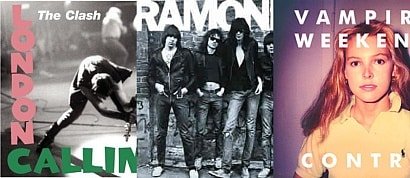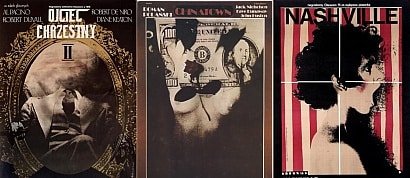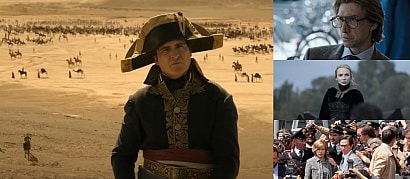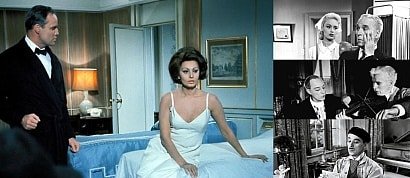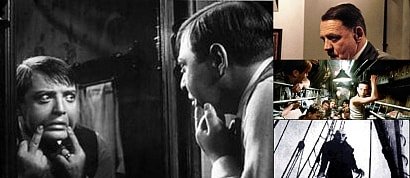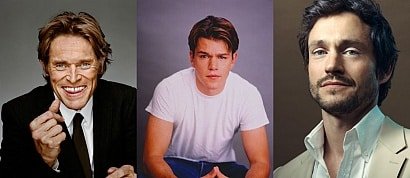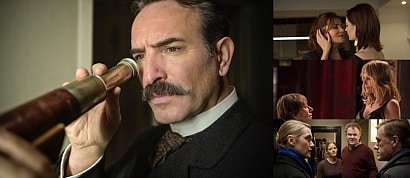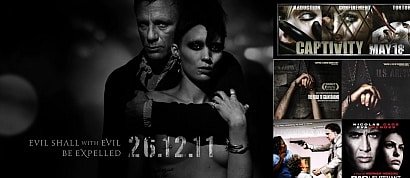What is Art?
Sort by:
Showing 1-50 of 80
Rating:
List Type:

Diane Arbus (March 14, 1923 – July 26, 1971) was an American photographer and writer noted for black-and-white square photographs of "deviant and marginal people (dwarfs, giants, transvestites, nudists, circus performers) or of people whose normality seems ugly or surreal."A friend said that Arbus said that she was "afraid... that she would be known simply as 'the photographer of freaks'"; however, that phrase has been used repeatedly to describe her.
In 1972, a year after she committed suicide, Arbus became the first American photographer to have photographs displayed at the Venice Biennale. Millions of people viewed traveling exhibitions of her work in 1972–1979. In 2003–2006, Arbus and her work were the subjects of another major traveling exhibition, Diane Arbus Revelations.
Although some of Arbus's photographs have sold for hundreds of thousands of dollars at auction, Arbus's work has provoked controversy; for example, Norman Mailer was quoted in 1971 as saying "Giving a camera to Diane Arbus is like putting a live grenade in the hands of a child."
(Source: Wikipedia)
Movie tips: Fur: An Imaginary Portrait of Diane Arbus
johanlefourbe's rating:



Giuseppe Arcimboldo (also spelled Arcimboldi) (1527 – July 11, 1593) was an Italian painter best known for creating imaginative portrait heads made entirely of such objects as fruits, vegetables, flowers, fish, and books – that is, he painted representations of these objects on the canvas arranged in such a way that the whole collection of objects formed a recognizable likeness of the portrait subject.
In 1562 he became court portraitist to Ferdinand I at the Habsburg court in Vienna, and later, to Maximilian II and his son Rudolf II at the court in Prague. He was also the court decorator and costume designer. King Augustus of Saxony, who visited Vienna in 1570 and 1573, saw Arcimboldo's work and commissioned a copy of his "The Four Seasons" which incorporates his own monarchic symbols.
Arcimboldo's conventional work, on traditional religious subjects, has fallen into oblivion, but his portraits of human heads made up of vegetables, plants, fruits, sea creatures and tree roots, were greatly admired by his contemporaries and remain a source of fascination today. Art critics debate whether these paintings were whimsical or the product of a deranged mind. A majority of scholars hold to the view, however, that given the Renaissance fascination with riddles, puzzles, and the bizarre (see, for example, the grotesque heads of Leonardo da Vinci), Arcimboldo, far from being mentally imbalanced, catered to the taste of his times.
(Source: Wikipedia)
Movie tips: -
johanlefourbe's rating:


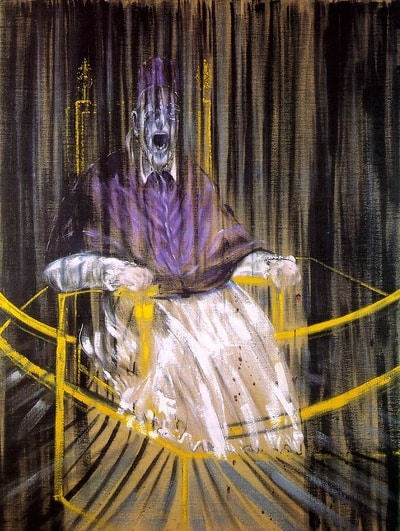
Francis Bacon (28 October 1909 – 28 April 1992), was an Anglo-Irish figurative painter known for his bold, austere, graphic and emotionally raw imagery. Bacon's painterly but abstract figures typically appear isolated in glass or steel geometrical cages set against flat, nondescript backgrounds. He began painting during his early 20s and worked only sporadically until his mid 30s. Before this time he drifted, earning his living as an interior decorator and designer of furniture and rugs. Later, he admitted that his career was delayed because he had spent too long looking for a subject that would sustain his interest. His breakthrough came with the 1944 triptych Three Studies for Figures at the Base of a Crucifixion, and it was this work and his heads and figures of the late 1940s through to the mid 1950s that sealed his reputation as a notably bleak chronicler of the human condition.
From the mid 1960s, Bacon mainly produced portrait heads of friends. He often said in interviews that he saw images "in series", and his artistic output often saw him focus on single themes for sustained periods including his crucifixion, Papal heads, and later single and triptych heads series. He began by painting variations on the Crucifixion and later focused on half human-half grotesque portraits, best exemplified by the 1949 "Heads in a Room" series. Following the 1971 suicide of his lover George Dyer, Bacon's art became more personal, inward looking and preoccupied with themes and motifs of death. The climax of this late period came with his 1982 "Study for Self-Portrait", and his late masterpiece Study for a Self Portrait -Triptych, 1985-86.
(Source: Wikipedia)
Movie tips: Love Is the Devil: Study for a Portrait of Francis Bacon
johanlefourbe's rating:



Banksy is a pseudonymous England-based graffiti artist, political activist, film director and painter.
His satirical street art and subversive epigrams combine irreverent dark humour with graffiti done in a distinctive stencilling technique. Such artistic works of political and social commentary have been featured on streets, walls, and bridges of cities throughout the world.
Banksy's work was born out of the Bristol underground scene which involved collaborations between artists and musicians. According to author and graphic designer Tristan Manco and the book Home Sweet Home, Banksy "was born in 1974 and raised in Bristol, England. The son of a photocopier technician, he trained as a butcher but became involved in graffiti during the great Bristol aerosol boom of the late 1980s." Observers have noted that his style is similar to Blek le Rat, who began to work with stencils in 1981 in Paris and members of the anarcho-punk band Crass, which maintained a graffiti stencil campaign on the London Tube System in the late 1970s and early 1980s and is active today.
(Source: Wikipedia)
Movie tips: Exit Through the Gift Shop
johanlefourbe's rating:



Jean-Michel Basquiat (December 22, 1960 – August 12, 1988) was an American artist. His career in art began as a graffiti artist in New York City in the late 1970s, and in the 1980s produced Neo-expressionist painting. Basquiat died of a heroin overdose on August 12, 1988, at the age of 27.
Continuing his activities as a graffiti artist, Basquiat often incorporated words into his paintings. Before his career as a painter began, he produced punk-inspired postcards for sale on the street, and become known for the political–poetical graffiti under the name of SAMO. On one occasion Basquiat painted his girlfriend's dress with the words "Little Shit Brown". He would often draw on random objects and surfaces.
The conjunction of various media is an integral element of Basquiat's art. His paintings are typically covered with text and codes of all kinds: words, letters, numerals, pictograms, logos, map symbols, diagrams and more.
(Source: Wikipedia)
Movie tips: Basquiat
johanlefourbe's rating:



Enes Bilal (born October 7, 1951) is a French comic book creator, comics artist and film director.
Born in Belgrade, Yugoslavia, to a Slovak mother and a Bosnian father who had been Josip Broz Tito's tailor, he moved to Paris at the age of 9. At age 14, he met René Goscinny and with his encouragement applied his talent to comics. He produced work for Goscinny's comics magazine Pilote in the 1970s, publishing his first story, Le Bal Maudit, in 1972.
In 1975, Bilal began working with script writer Pierre Christin on a series of dark and surreal tales, resulting in the body of work titled Légendes d'Aujourd'hui.
He is best known for the Nikopol trilogy (La Foire aux Immortels, La Femme Piège and Froid Équateur), which took more than a decade to complete. Bilal wrote the script and did the artwork. The final chapter, Froid Équateur, was chosen book of the year by the magazine Lire and is acknowledged by the inventor of chess boxing, Iepe Rubingh as the inspiration for the sport.
Bilal's most recent publication is Quatre? (2007), the last book in the Hatzfeld tetralogy, which deals with the breakup of Yugoslavia from a future viewpoint. The first installment came in 1998 in the shape of Le Sommeil du Monstre opening with the main character, Nike, remembering the war in a series of traumatic flashbacks. The third chapter of the tetralogy is titled Rendez-vous à Paris (2006). It gives a good indication of Bilal's popularity, being the fifth best selling new French comic of 2006 with 280,000 copies.
His cinematic career has recently been revived with the expensive Immortel (Ad Vitam) which is his first attempt to adapt his books to the screen. The film received split critics, some panning the use of CGI characters but others have seen it as a faithful reinterpretation of the books.
On May 13, 2008 a video game based on the Nikopol trilogy was announced entitled Nikopol: Secrets of the Immortals. Published in North America by Got Game Entertainment in August 2008, the game is a "point and click" adventure for the PC; however, the Lead Designer was Benoit Sokal and not Bilal himself, who was the art designer, along with Yoshitaka Amano for the upcoming video game Beyond Good & Evil 2.
(Source: Wikipedia)
Movie tips: Immortel (ad vitam)
johanlefourbe's rating:



Simon Bisley (born March 4, 1962) is a British comics artist best known for his 1990s work on ABC Warriors, Lobo and Sláine. His style, reliant on paints, acrylics, inks and multiple-mediums, was strongly influenced by Frank Frazetta, Gustav Klimt, Salvador Dalí, William Turner and Richard Corben. He also took inspiration from rock album covers and graffiti as well as traditional comics art. In turn he and his work has inspired various forms in media, including the Beast in the 2006 Doctor Who episode "The Satan Pit", and Simon Pegg's character graphic artist Tim Bisley on the Channel 4 sitcom Spaced.
(Source: Wikipedia)
Movie tips: -
suggested by silent killer
johanlefourbe's rating:



William Blake (28 November 1757 – 12 August 1827) was an English poet, painter, and printmaker. Largely unrecognised during his lifetime, Blake is now considered a seminal figure in the history of both the poetry and visual arts of the Romantic Age. His prophetic poetry has been said to form "what is in proportion to its merits the least read body of poetry in the English language". His visual artistry has led one contemporary art critic to proclaim him "far and away the greatest artist Britain has ever produced". Although he lived in London his entire life except for three years spent in Felpham he produced a diverse and symbolically rich corpus, which embraced the imagination as "the body of God", or "Human existence itself".
Considered mad by contemporaries for his idiosyncratic views, Blake is held in high regard by later critics for his expressiveness and creativity, and for the philosophical and mystical undercurrents within his work. His paintings and poetry have been characterised as part of both the Romantic movement and "Pre-Romantic", for its large appearance in the 18th century. Reverent of the Bible but hostile to the Church of England - indeed, to all forms of organised religion - Blake was influenced by the ideals and ambitions of the French and American revolutions, as well as by such thinkers as Jakob Böhme and Emanuel Swedenborg.
Despite these known influences, the singularity of Blake's work makes him difficult to classify. The 19th century scholar William Rossetti characterised Blake as a "glorious luminary," and as "a man not forestalled by predecessors, nor to be classed with contemporaries, nor to be replaced by known or readily surmisable successors".
(Source: Wikipedia)
Movie tips: -
johanlefourbe's rating:



Fernando Botero Angulo (born April 19, 1932) is a Colombian figurative artist, self-titled "the most Colombian of Colombian artists" early on. He came to national prominence when he won the first prize at the Salón de Artistas Colombianos in 1958. Working most of the year in Paris, in the last three decades he has achieved international recognition for his paintings, drawings and sculpture, with exhibitions across the world. His art is collected by major museums, corporations and private collectors.
While his work includes still-lifes and landscapes, Botero has concentrated on situational portraiture. His paintings and sculptures are united by their proportionally exaggerated, or "fat" figures, as he once referred to them.
Botero is an abstract artist in the most fundamental sense, choosing colors, shapes, and proportions based on intuitive aesthetic thinking. Though he spends only one month a year in Colombia, he considers himself the "most Colombian artist living" due to his insulation from the international trends of the art world.
(Source: Wikipedia)
Movie tips: -
johanlefourbe's rating:



Alessandro di Mariano di Vanni Filipepi, better known as Sandro Botticelli (c. 1445 – May 17, 1510) was an Italian painter of the Early Renaissance. He belonged to the Florentine school under the patronage of Lorenzo de' Medici, a movement that Giorgio Vasari would characterize less than a hundred years later as a "golden age", a thought, suitably enough, he expressed at the head of his Vita of Botticelli. Botticelli's posthumous reputation suffered until the late 19th century; since then his work has been seen to represent the linear grace of Early Renaissance painting. Among his best known works are The Birth of Venus and Primavera.
In these works, the influence of Gothic realism is tempered by Botticelli's study of the antique. But if the painterly means may be understood, the subjects themselves remain fascinating for their ambiguity. The complex meanings of these paintings continue to receive widespread scholarly attention, mainly focusing on the poetry and philosophy of humanists who were the artist's contemporaries. The works do not illustrate particular texts; rather, each relies upon several texts for its significance. Of their beauty, characterized by Vasari as exemplifying "grace" and by John Ruskin as possessing linear rhythm, there can be no doubt.
(Source: Wikipedia)
Movie tips: -
johanlefourbe's rating:



Mr. Brainwash ("MBW") is a pseudonym for Thierry Guetta. According to the Banksy directed film Exit Through the Gift Shop, Guetta who now lives in Los Angeles, California, having been a proprietor of a clothing store and videographer who evolved into a street artist and gallery artist, influenced by the street artists he documented through video over the years. According to the film, Guetta was first introduced to street art by his cousin, the street artist, Invader.
The artwork attributed to Guetta strongly emulates the styles and artistic concepts of well-known street artists including Banksy and Shepard Fairey. Like Banksy, Guetta employs famous artistic and historic images, many of which are copyrighted, and amends the originals in slight or significant ways. Unlike Banksy, who is shown in the film creating his own work, Guetta states in the film that his work largely consists of "scanning and photoshopping," acts which are carried out by hired assistants. Guetta further admits that most of the actual artistic process is carried out by hired graphic designers to whom he describes his ideas.
Guetta's first show Life is Beautiful opened in Los Angeles, California, June 18, 2008. In 2009, Guetta created the cover art for Madonna's Celebration album. On February 14, 2010, his second show ICONS opened in New York City.
(Source: Wikipedia)
Movie tips: Exit Through the Gift Shop
johanlefourbe's rating:



Michelangelo Merisi da Caravaggio (29 September 1571 – 18 July 1610) was an Italian artist active in Rome, Naples, Malta, and Sicily between 1593 and 1610. His paintings, which combine a realistic observation of the human state, both physical and emotional, with a dramatic use of lighting, had a formative influence on the Baroque school of painting.
Caravaggio trained as a painter in Milan under a master who had himself trained under Titian. In his early twenties Caravaggio moved to Rome where, during the late 16th and early 17th centuries, many huge new churches and palazzi were being built and paintings were needed to fill them. During the Counter-Reformation the Roman Catholic Church searched for religious art with which to counter the threat of Protestantism, and for this task the artificial conventions of Mannerism, which had ruled art for almost a century, no longer seemed adequate. Caravaggio's novelty was a radical naturalism that combined close physical observation with a dramatic, even theatrical, use of chiaroscuro. This came to be known as Tenebrism, the shift from light to dark with little intermediate value. He burst upon the Rome art scene in 1600 with the success of his first public commissions, the Martyrdom of Saint Matthew and Calling of Saint Matthew. Thereafter he never lacked commissions or patrons, yet he handled his success atrociously. He was jailed on several occasions, vandalized his own apartment, and ultimately had a death warrant issued for him by the Pope. An early published notice on him, dating from 1604 and describing his lifestyle three years previously, tells how "after a fortnight's work he will swagger about for a month or two with a sword at his side and a servant following him, from one ball-court to the next, ever ready to engage in a fight or an argument, so that it is most awkward to get along with him." In 1606 he killed a young man in a brawl and fled from Rome with a price on his head. He was involved in a brawl in Malta in 1608, and another in Naples in 1609, possibly a deliberate attempt on his life by unidentified enemies. This encounter left him severely injured. A year later, at the age of 38, he died of a fever in Porto Ercole, near Grosseto in Tuscany, while on his way to Rome to receive a pardon.
Infamous while he lived, Caravaggio was forgotten almost immediately after his death, and it was only in the 20th century that his importance to the development of Western art was rediscovered. Despite this, his influence on the new Baroque style that eventually emerged from the ruins of Mannerism was profound. It can be seen directly or indirectly in the work of Rubens, Jusepe de Ribera, Bernini, and Rembrandt, and artists in the following generation heavily under his influence were called the "Caravaggisti" or "Caravagesques", as well as Tenebrists or "Tenebrosi" ("shadowists"). Andre Berne-Joffroy, Paul Valéry's secretary, said of him: "What begins in the work of Caravaggio is, quite simply, modern painting."
(Source: Wikipedia)
Movie tips: Caravaggio
johanlefourbe's rating:



Henri Cartier-Bresson (August 22, 1908 – August 3, 2004) was a French photographer considered to be the father of modern photojournalism. He was an early adopter of 35 mm format, and the master of candid photography. He helped develop the "street photography" or "real life reportage" style that has influenced generations of photographers who followed.
Cartier-Bresson exclusively used Leica 35 mm rangefinder cameras equipped with normal 50 mm lenses or occasionally a wide-angle for landscapes. He often wrapped black tape around the camera's chrome body to make it less conspicuous. With fast black and white films and sharp lenses, he was able to photograph almost by stealth to capture the events. No longer bound by a huge 4×5 press camera or an awkward medium format twin-lens reflex camera, miniature-format cameras gave Cartier-Bresson what he called "the velvet hand [and] the hawk's eye."
He believed in composing his photographs in the viewfinder, not in the darkroom. He showcased this belief by having nearly all his photographs printed only at full-frame and completely free of any cropping or other darkroom manipulation. Indeed, he emphasized that his prints were not cropped by insisting they include the first millimetre or so of the unexposed clear negative around the image area resulting, after printing, in a black border around the positive image.
Cartier-Bresson worked exclusively in black and white, other than a few unsuccessful attempts in color. He disliked developing or making his own prints. He said: "I've never been interested in the process of photography, never, never. Right from the beginning. For me, photography with a small camera like the Leica is an instant drawing."
He started the tradition of testing new camera lenses by taking photographs of ducks in urban parks. He never published the images but referred to them as 'my only superstition' as he considered it a 'baptism' of the lens.
Cartier-Bresson is regarded as one of the art world's most unassuming personalities. He disliked publicity and exhibited a ferocious shyness since his days in hiding from the Nazis during World War II. Although he took many famous portraits, his own face was little known to the world at large (which presumably had the advantage of allowing him to work on the street in peace). He dismissed others' applications of the term "art" to his photographs, which he thought were merely his gut reactions to moments in time that he had happened upon.
(Source: Wikipedia)
Movie tips: -
johanlefourbe's rating:



Paul Cézanne (1839–1906) was a French artist and Post-Impressionist painter whose work laid the foundations of the transition from the 19th century conception of artistic endeavour to a new and radically different world of art in the 20th century. Cézanne can be said to form the bridge between late 19th century Impressionism and the early 20th century's new line of artistic enquiry, Cubism. The line attributed to both Matisse and Picasso that Cézanne "is the father of us all" cannot be easily dismissed.
Cézanne's work demonstrates a mastery of design, colour, tone, composition and draughtsmanship. His often repetitive, sensitive and exploratory brushstrokes are highly characteristic and clearly recognizable. He used planes of colour and small brushstrokes that build up to form complex fields, at once both a direct expression of the sensations of the observing eye and an abstraction from observed nature. The paintings convey Cézanne's intense study of his subjects, a searching gaze and a dogged struggle to deal with the complexity of human visual perception.
(Source: Wikipedia)
Movie tips: -
johanlefourbe's rating:



Marc Chagall (6 July 1887 – 28 March 1985), was a Belorussian-French artist associated with several major artistic styles and one of the most successful artists of the 20th century. He was an early modernist, and created works in virtually every artistic medium, including painting, book illustrations, stained glass, stage sets, ceramic, tapestries and fine art prints.
Art critic Robert Hughes referred to Chagall as "the quintessential Jewish artist of the twentieth century." According to art historian Michael J. Lewis, Chagall was considered to be "the last survivor of the first generation of European modernists." For decades, he "had also been respected as the world's preeminent Jewish artist." Using the medium of stained glass, he produced windows for the cathedrals of Reims and Metz, windows for the UN, and the Jerusalem Windows in Israel. He also did large-scale paintings, including part of the ceiling of the Paris Opéra.
Before World War I, he traveled between St. Petersburg, Paris, and Berlin. During this period he created his own mixture and style of modern art based on his idea of Eastern European Jewish folk culture. He spent the wartime years in Soviet Belarus, becoming one of the country's most distinguished artists and a member of the modernist avante-garde, initiating the Vitebsk Arts College before leaving again for Paris during 1922.
He had two basic reputations, writes Lewis: as a pioneer of modernism and as a major Jewish artist. He experienced modernism's "golden age" in Paris, where "he synthesized the art forms of Cubism, Symbolism, and Fauvism, and the influence of Fauvism gave rise to Surrealism." Yet throughout these phases of his style "he remained most emphatically a Jewish artist, whose work was one long dreamy reverie of life in his native village of Vitebsk." "When Matisse dies," Pablo Picasso remarked during the 1950s, "Chagall will be the only painter left who understands what colour really is."
(Source: Wikipedia)
Movie tips: -
johanlefourbe's rating:



Charles Thomas "Chuck" Close (born July 5, 1940, Monroe, Washington) is an American painter and photographer who achieved fame as a photorealist, through his massive-scale portraits. Though a catastrophic spinal artery collapse in 1988 left him severely paralyzed, he has continued to paint and produce work that remains sought after by museums and collectors.
Most of his early works are very large portraits based on photographs (Photorealism or Hyperrealism technique) of family and friends, often other artists. In 1962, he received his B.A. from the University of Washington in Seattle. He then attended graduate school at Yale University, where he received his MFA in 1964. After Yale, he lived in Europe for a while on a Fulbright grant. When he returned to the US, he worked as an art teacher at the University of Massachusetts.
Close had been known for his skillful brushwork as a graduate student at Yale University. As he explained in a 2009 interview with the Cleveland Ohio Plain Dealer, he made a choice in 1967 to make art hard for himself and force a personal artistic breakthrough by abandoning the paintbrush. "I threw away my tools", Close said. "I chose to do things I had no facility with. The choice not to do something is in a funny way more positive than the choice to do something. If you impose a limit to not do something you've done before, it will push you to where you've never gone before."
(Source: Wikipedia)
Movie tips: -
johanlefourbe's rating:



Richard Corben (born October 1, 1940) is an American illustrator and comic book artist best known for his comics featured in Heavy Metal magazine. He is the winner of the 2009 Spectrum Grand Master Award.
Richard Corben was born on a farm in Anderson, Missouri, and went on to get a Bachelor of Fine Arts degree from the Kansas City Art Institute, in 1965.
After working as a professional animator, Corben started doing underground comics, including Grim Wit, Slow Death, Skull, Rowlf, Fever Dreams and his own anthology Fantagor. In 1970 he began illustrating horror and science-fiction stories for Warren Publishing. His stories appeared in Creepy, Eerie, Vampirella, 1984 and Comix International. He also colored several episodes of Will Eisner's Spirit.
In 1975, when Moebius, Druillet, and Jean-Pierre Dionnet started publishing the magazine Métal Hurlant in France, Corben submitted some of his stories to them. He continued his work for the franchise in America, where the magazine was called Heavy Metal. In 1976 he adapted a short Robert E. Howard story in an early graphic novel, Bloodstar.
Among the stories drawn for Heavy Metal he continued the saga of his most famous creation, Den which had begun in the short film Neverwhere (Neil Gaiman used the same title, Neverwhere, later, but the two creations have nothing common) and a short story in the underground publication Grim Wit #2. The saga of Den is a fantasy series about the adventures of a young underweight nerd who travels to Neverwhere, a universe taking inspirational nods from Robert E. Howard's Hyborian Age, Edgar Rice Burroughs's Barsoom and H. P. Lovecraft's horror dimensions. There, the boy becomes an enormously endowed nude muscleman who has erotic adventures in a world of outrageous dangers, hideous monsters, and buxom nude women who lustfully throw themselves at him. This story was adapted in a highly abridged form in the animated film Heavy Metal, where Den was voiced by John Candy.
Corben's collaborations are varied, ranging from Rip in Time with Bruce Jones, to Harlan Ellison for Vic and Blood, to the Den Saga, the Mutant World titles, Jeremy Brood, and The Arabian Nights with Jan Strnad.
From 1986–1994 Corben operated his own publishing imprint, Fantagor Press. Among the titles Fantagor published were Den, Den Saga, Horror in the Dark, Rip in Time, and Son of Mutant World. Fantagor went out of business after the 1994 contraction of the comics industry.
(Source: Wikipedia)
Movie tips: -
johanlefourbe's rating:



Salvador Domènec Felip Jacint Dalí i Domènech, Marquis de Púbol (May 11, 1904 – January 23, 1989), commonly known as Salvador Dalí was a prominent Spanish Catalan surrealist painter born in Figueres.
Dalí was a skilled draftsman, best known for the striking and bizarre images in his surrealist work. His painterly skills are often attributed to the influence of Renaissance masters. His best-known work, The Persistence of Memory, was completed in 1931. Dalí's expansive artistic repertoire includes film, sculpture, and photography, in collaboration with a range of artists in a variety of media.
Dalí was highly imaginative, and also had an affinity for partaking in unusual and grandiose behavior. His eccentric manner and attention-grabbing public actions sometimes drew more attention than his artwork to the dismay of those who held his work in high esteem and to the irritation of his critics.
(Source: Wikipedia)
Movie tips: Little Ashes
johanlefourbe's rating:



Leonardo di ser Piero da Vinci (April 15, 1452 – May 2, 1519) was an Italian Renaissance polymath: painter, sculptor, architect, musician, scientist, mathematician, engineer, inventor, anatomist, geologist, cartographer, botanist and writer. Leonardo has often been described as the archetype of the Renaissance Man, a man of "unquenchable curiosity" and "feverishly inventive imagination". He is widely considered to be one of the greatest painters of all time and perhaps the most diversely talented person ever to have lived. According to art historian Helen Gardner, the scope and depth of his interests were without precedent and "his mind and personality seem to us superhuman, the man himself mysterious and remote". Marco Rosci points out, however, that while there is much speculation about Leonardo, his vision of the world is essentially logical rather than mysterious, and that the empirical methods he employed were unusual for his time.
Born out of wedlock to a notary, Piero da Vinci, and a peasant woman, Caterina, at Vinci in the region of Florence, Leonardo was educated in the studio of the renowned Florentine painter, Verrocchio. Much of his earlier working life was spent in the service of Ludovico il Moro in Milan. He later worked in Rome, Bologna and Venice and spent his last years in France, at the home awarded him by Francis I.
(Source: Wikipedia)
Movie tips: -
johanlefourbe's rating:



Edgar Degas (1834–1917), born Hilaire-Germain-Edgar De Gas, was a French artist famous for his work in painting, sculpture, printmaking and drawing. He is regarded as one of the founders of Impressionism although he rejected the term, and preferred to be called a realist. A superb draughtsman, he is especially identified with the subject of the dance, and over half of his works depict dancers. These display his mastery in the depiction of movement, as do his racecourse subjects and female nudes. His portraits are notable for their psychological complexity and depiction of human isolation.
Early in his career, he wanted to be a history painter, a calling for which he was well prepared by his rigorous academic training and close study of classic art. In his early thirties, he changed course, and by bringing the traditional methods of a history painter to bear on contemporary subject matter, he became a classical painter of modern life.
(Source: Wikipedia)
Movie tips: -
johanlefourbe's rating:



Willem de Kooning (April 24, 1904 – March 19, 1997) was a Dutch American abstract expressionist artist who was born in Rotterdam, the Netherlands.
In the post-World War II era, de Kooning painted in a style that came to be referred to as Abstract expressionism or Action painting, and was part of a group of artists that came to be known as the New York School. Other painters in this group included Jackson Pollock, Franz Kline, Arshile Gorky, Mark Rothko, Hans Hofmann, Adolph Gottlieb, Robert Motherwell, Philip Guston and Clyfford Still.
In September 2011 de Kooning's work was honored with a large-scale retrospective exhibition: de Kooning: A Retrospective September 18, 2011–January 9, 2012 at MoMA in New York City. Organized by John Elderfield it's the first major museum exhibition devoted to the full breadth and depth of de Kooning's career, containing nearly 200 works.
The hallmark of de Kooning's style was an emphasis on complex figure ground ambiguity. Background figures would overlap other figures causing them to appear in the foreground, which in turn might be overlapped by dripping lines of paint thus positioning the area into the background.
(Source: Wikipedia)
Movie tips: -
johanlefourbe's rating:



Ferdinand Victor Eugène Delacroix (26 April 1798 – 13 August 1863) was a French Romantic artist regarded from the outset of his career as the leader of the French Romantic school. Delacroix's use of expressive brushstrokes and his study of the optical effects of colour profoundly shaped the work of the Impressionists, while his passion for the exotic inspired the artists of the Symbolist movement. A fine lithographer, Delacroix illustrated various works of William Shakespeare, the Scottish writer Walter Scott and the German writer Johann Wolfgang von Goethe.
In contrast to the Neoclassical perfectionism of his chief rival Ingres, Delacroix took for his inspiration the art of Rubens and painters of the Venetian Renaissance, with an attendant emphasis on colour and movement rather than clarity of outline and carefully modeled form. Dramatic and romantic content characterized the central themes of his maturity, and led him not to the classical models of Greek and Roman art, but to travel in North Africa, in search of the exotic. Friend and spiritual heir to Théodore Géricault, Delacroix was also inspired by Lord Byron, with whom he shared a strong identification with the "forces of the sublime", of nature in often violent action.
However, Delacroix was given neither to sentimentality nor bombast, and his Romanticism was that of an individualist. In the words of Baudelaire, "Delacroix was passionately in love with passion, but coldly determined to express passion as clearly as possible."
(Source: Wikipedia)
Movie tips: -
johanlefourbe's rating:



Robert Doisneau (14 April 1912– 1 April 1994) was a French photographer. In the 1930s he used a Leica on the streets of Paris; together with Henri Cartier-Bresson he was a pioneer of photojournalism. He is renowned for his 1950 image Le baiser de l'hôtel de ville (Kiss by the Hôtel de Ville), a photo of a couple kissing in the busy streets of Paris. Robert Doisneau was appointed a Chevalier (Knight) of the National Order of the Légion d'honneur in 1984.
Robert Doisneau was known for his modest, playful, and ironic images of amusing juxtapositions, mingling social classes, and eccentrics in contemporary Paris streets and cafes. Influenced by the work of André Kertész, Eugène Atget, and Henri Cartier-Bresson, in over twenty books Doisneau presented a charming vision of human frailty and life as a series of quiet, incongruous moments.
(Source: Wikipedia)
Movie tips: -
johanlefourbe's rating:



Henri-Robert-Marcel Duchamp (28 July 1887 – 2 October 1968) was a French painter, sculptor, chess player, and writer whose work is associated with Cubism, Dada, and conceptual art. He is commonly regarded, along with Pablo Picasso and Henri Matisse, as one of the three artists who helped to define the revolutionary developments in the plastic arts in the opening decades of the 20th century, responsible for significant developments in painting and sculpture. He has had an immense impact on 20th- and 21st-century art, and a seminal influence on the development of conceptual art. By the time of World War I, he had rejected the work of many of his fellow artists (such as Henri Matisse) as "retinal", intended only to please the eye. Instead, he wanted to use art to serve the mind.
(Source: Wikipedia)
Movie tips: -
johanlefourbe's rating:



Max Ernst (2 April 1891 – 1 April 1976) was a German painter, sculptor, graphic artist, and poet. A prolific artist, Ernst was one of the primary pioneers of the Dada movement and Surrealism.
Constantly experimenting, in 1925 he invented a graphic art technique called frottage (see Surrealist techniques), which uses pencil rubbings of objects as a source of images. He also created another technique called 'grattage' in which paint is scraped across canvas to reveal the imprints of the objects placed beneath. He uses this technique in his famous painting Forest and Dove.
(Source: Wikipedia)
Movie tips: -
johanlefourbe's rating:



Maurits Cornelis Escher (17 June 1898 – 27 March 1972), usually referred to as M. C. Escher, was a Dutch graphic artist. He is known for his often mathematically inspired woodcuts, lithographs, and mezzotints. These feature impossible constructions, explorations of infinity, architecture, and tessellations.
Escher's first print of an impossible reality was Still Life and Street, 1937. His artistic expression was created from images in his mind, rather than directly from observations and travels to other countries. Well known examples of his work also include Drawing Hands, a work in which two hands are shown, each drawing the other; Sky and Water, in which light plays on shadow to morph the water background behind fish figures into bird figures on a sky background; and Ascending and Descending, in which lines of people ascend and descend stairs in an infinite loop, on a construction which is impossible to build and possible to draw only by taking advantage of quirks of perception and perspective.
He worked primarily in the media of lithographs and woodcuts, though the few mezzotints he made are considered to be masterpieces of the technique. In his graphic art, he portrayed mathematical relationships among shapes, figures and space. Additionally, he explored interlocking figures using black and white to enhance different dimensions. Integrated into his prints were mirror images of cones, spheres, cubes, rings and spirals.
(Source: Wikipedia)
Movie tips: -
johanlefourbe's rating:



Frank Frazetta (February 9, 1928 – May 10, 2010) was an American fantasy and science fiction artist, noted for work in comic books, paperback book covers, paintings, posters, LP record album covers and other media. He was the subject of a 2003 documentary.
Frazetta was inducted into the comic book industry's Will Eisner Comic Book Hall of Fame in 1995 and the Jack Kirby Hall of Fame in 1999.
In 1944, at age 15, Frazetta, who had "always had this urge to be doing comic books", began working in comics artist Bernard Baily's studio doing pencil clean-ups. His first comic-book work was inking the eight-page story "Snowman", penciled by John Giunta, in the one-shot Tally-Ho Comics (Dec. 1944), published by Swappers Quarterly and Almanac/Baily Publishing Company. It was not standard practice in comic books during this period to provide complete credits, so a comprehensive listing of Frazetta's work is difficult to ascertain. Frazetta was soon drawing comic books in many genres, including Westerns, fantasy, mystery, and historical drama. In the early 1950s, he worked for EC Comics, National Comics, (including the superhero feature "Shining Knight"), Avon Comics, and several other comic book companies. Much of his work in comic books was done in collaboration with friend Al Williamson and mentor Roy Krenkel.
In 1964, Frazetta's painting of Beatle Ringo Starr for a Mad magazine ad parody caught the eye of United Artists studios. He was approached to do the movie poster for What's New Pussycat?, and earned the equivalent of his yearly salary in one afternoon. He did several other movie posters.
Frazetta also produced paintings for paperback editions of adventure books. His interpretation of Conan visually redefined the genre of sword and sorcery, and had an enormous influence on succeeding generations of artists. From this point on, Frazetta's work was in great demand. His covers were used for other paperback editions of classic Edgar Rice Burroughs books, such as those from the Tarzan and Barsoom (John Carter of Mars) series. He also did several pen and ink illustrations for many of these books. His cover art only coincidentally matched the storylines inside the books.
Frazetta retained the original Conan paintings, and long refused to part with them. Many were displayed at the Frazetta Museum in East Stroudsburg, Pennsylvania. In 2009, Frazetta's "Conan the Conqueror" painting, the first to be offered for sale, was purchased for $1 million.
(Source: Wikipedia)
Movie tips: -
johanlefourbe's rating:



Eugène Henri Paul Gauguin (7 June 1848 – 8 May 1903) was a leading French Post-Impressionist artist. He was an important figure in the Symbolist movement as a painter, sculptor, print-maker, ceramist, and writer. His bold experimentation with coloring led directly to the Synthetist style of modern art while his expression of the inherent meaning of the subjects in his paintings, under the influence of the cloisonnist style, paved the way to Primitivism and the return to the pastoral. He was also an influential proponent of wood engraving and woodcuts as art forms.
Primitivism was an art movement of late 19th century painting and sculpture; characterized by exaggerated body proportions, animal totems, geometric designs and stark contrasts. The first artist to systematically use these effects and achieve broad public success was Paul Gauguin. The European cultural elite discovering the art of Africa, Micronesia, and Native Americans for the first time were fascinated, intrigued and educated by the newness, wildness and the stark power embodied in the art of those faraway places. Like Pablo Picasso in the early days of the 20th century, Gauguin was inspired and motivated by the raw power and simplicity of the so-called Primitive art of those foreign cultures.
Gauguin is also considered a Post-Impressionist painter. His bold, colorful and design oriented paintings significantly influenced Modern art. Artists and movements in the early 20th century inspired by him include Vincent van Gogh, Henri Matisse, Pablo Picasso, Georges Braque, André Derain, Fauvism, Cubism and Orphism, among others. Later he influenced Arthur Frank Mathews and the American Arts and Crafts Movement.
(Source: Wikipedia)
Movie tips: Paradise Found, Oviri
johanlefourbe's rating:



Rick Genest (born August 7, 1985) is a Canadian artist and fashion model born in Montreal. He is also known as Zombie Boy for being tattooed like a corpse across the majority of his body. It was not until the age of 21 that he would first come to Montreal tattoo artist Frank Lewis, since then responsible for inking the majority of the designs on his body, which they create together. This has taken over three years, Genest spending thousands of dollars on the artwork, conceived by him to be "about the human body as a decomposing corpse – the art of a rotting cadaver.", and "also a tribute to horror movies", a favourite genre of his.
(Source: Wikipedia)
Movie tips: -
johanlefourbe's rating:



Hans Rudolf "H.R." Giger (5 February 1940 – 12 May 2014) was a Swiss surrealist painter, whose style was adapted for many forms of media, including record-albums, furniture and tattoo-art.
The Zurich-based artist was best known for airbrush images of humans and machines linked together in a cold 'biomechanical' relationship. Later he abandoned airbrush work for pastels, markers or ink. He was part of the special effects team that won an Academy Award for design work on the film Alien. In Switzerland there are two theme-bars that reflect his interior designs, and his work is on permanent display at the H.R. Giger Museum at Gruyères.
(Source: Wikipedia)
Movie tips: -
johanlefourbe's rating:



Juan Antonio Giménez López (born November 16, 1943) is an Argentine comic book artist.
Giménez López was born in Mendoza, Argentina. He finished his high school education as an industrial designer and later attended the Academy of Fine Arts in Barcelona (Spain).
His first stories, for Argentine editors such as Colomba and Record, were largely inspired by Hugo Pratt (during the years he spent in Argentina) and Francisco Solano López. Back to Spain, he worked for Spanish (Zona 84, Comix International) and Italian (Lanciostory, Skorpio) magazines. His work of this period is mainly related to war and science-fiction genres.
In 1980, he designed the "Harry Canyon" segment of the film Heavy Metal. During the 1980s, he collaborated with several European magazines, including the Spanish 1984, the French Metal Hurlant and the Italian L'Eternauta, experimenting with graphical and narrative innovations. To this period dates what is ranked among his best series, the short science-fictions stories known under the title of Time Paradox. Also noteworthy are The City, written by Ricardo Barreiro and Le Quatrième Pouvoir (The Fourth Power), which he wrote by himself.
Giménez's style has become famous for the extreme attention he devotes to technical and historical details; his series Pik As has been defined as a comic encyclopaedia of World War II.
Giménez also collaborated with important authors such as Carlos Trillo, Emilio Balcarce, Roberto Dal Prà, and Chilean Alejandro Jodorowsky, with whom he authored the popular Metabarons saga started in 1992.
(Source: Wikipedia)
Comic-book tips: La Caste des Méta-Barons
johanlefourbe's rating:



Jean Henri Gaston Giraud (born May 8, 1938) is a French comics artist. Giraud has earned worldwide fame, not only under his own name but also under the pseudonym Moebius.
At 18, Giraud was drawing his own comic strip, "Frank et Jeremie" for the magazine Far West. In 1961, Giraud became an apprentice of Jijé, one of the leading comic artists in Europe of the time, and collaborated on an album of Jerry Spring. In 1962 Giraud and writer Jean-Michel Charlier started the comic strip Fort Navajo for Pilote. It was a great hit and continued uninterrupted until 1974. The Lieutenant Blueberry character, created by Giraud and Charlier for Fort Navajo, quickly became its most popular character, and his adventures as told in the spin-off Western serial Blueberry, are possibly Giraud's best known work in his native France before his later collaborations with Alejandro Jodorowsky. Giraud's prestige in France – where comics are held in high artistic regard – is enormous; In 1988 Moebius was chosen, among 11 other winners of the prestigious Grand Prix of the Angoulême Festival, to illustrate a postage stamp set issued on the theme of communication. Under the names Giraud and Gir, he also wrote numerous comics for other comic artists like Auclair and Tardi.
The Moebius pseudonym, which Giraud came to use for his science fiction and fantasy work, was born in 1963. In a satire magazine called Hara-Kiri, Moebius did 21 strips in 1963–64 and then disappeared for almost a decade. In 1975 Métal Hurlant (a magazine which he co-created) brought it back and in 1981 he started his famous L'Incal series in collaboration with Alejandro Jodorowsky. Moebius' famous serial The Airtight Garage and his groundbreaking Arzach also began in Métal Hurlant.
Moebius has contributed storyboards and concept designs to numerous science fiction films. In 1982 he collaborated with director René Laloux to create the science fiction feature-length animated movie Les Maîtres du temps (released in English as Time Masters) based on a novel by Stefan Wul. In 1988 Moebius worked on the American comic character The Silver Surfer with Stan Lee for a special two-part limited series. Giraud also happens to be a friend of filmmaker Hayao Miyazaki. From December 2004 to March 2005, the two of them shared an exhibition at La Monnaie in Paris which showcased work by both artists.
(Source: Wikipedia)
Comic-book tips: L'Incal
johanlefourbe's rating:



Francisco José de Goya y Lucientes (30 March 1746 – 16 April 1828) was a Spanish romantic painter and printmaker regarded both as the last of the Old Masters and the first of the moderns. Goya was a court painter to the Spanish Crown, and through his works was both a commentator on and chronicler of his era. The subversive and imaginative element in his art, as well as his bold handling of paint, provided a model for the work of later generations of artists, notably Manet, Picasso and Francis Bacon.
Goya painted the Spanish royal family, including Charles IV of Spain and Ferdinand VII. His themathic range extended from merry festivals for tapestry, draft cartoons, to scenes of war and human debasment. This evolution reflects the darkening of his temper. Modern physicians suspect that the lead in his pigments poisoned him and caused his deafness since 1792. Near the end of his life, he became reclusive and produced frightening and obscure paintings of insanity, madness, and fantasy, while the style of the Black Paintings prefigure the expressionist movement.
(Source: Wikipedia)
Movie tips: Goya's Ghosts
johanlefourbe's rating:



El Greco (1541 – April 7, 1614) was a painter, sculptor and architect of the Spanish Renaissance. "El Greco" (The Greek) was a nickname, a reference to his Greek origin, and the artist normally signed his paintings with his full birth name in Greek letters, Δομήνικος Θεοτοκόπουλος (Doménikos Theotokópoulos).
El Greco was born on Crete, which was at that time part of the Republic of Venice, and the centre of Post-Byzantine art. He trained and became a master within that tradition before travelling at age 26 to Venice, as other Greek artists had done. In 1570 he moved to Rome, where he opened a workshop and executed a series of works. During his stay in Italy, El Greco enriched his style with elements of Mannerism and of the Venetian Renaissance. In 1577, he moved to Toledo, Spain, where he lived and worked until his death. In Toledo, El Greco received several major commissions and produced his best-known paintings.
El Greco's dramatic and expressionistic style was met with puzzlement by his contemporaries but found appreciation in the 20th century. El Greco is regarded as a precursor of both Expressionism and Cubism, while his personality and works were a source of inspiration for poets and writers such as Rainer Maria Rilke and Nikos Kazantzakis. El Greco has been characterized by modern scholars as an artist so individual that he belongs to no conventional school. He is best known for tortuously elongated figures and often fantastic or phantasmagorical pigmentation, marrying Byzantine traditions with those of Western painting.
(Source: Wikipedia)
Movie tips: El Greco
johanlefourbe's rating:



Keith Haring (May 4, 1958 – February 16, 1990) was an artist and social activist whose work responded to the New York City street culture of the 1980s.
Haring achieved his first public attention with chalk drawings in the subways of New York (see public art). These were his first recognized pieces of pop art. The exhibitions were filmed by the photographer Tseng Kwong Chi. Around this time, "The Radiant baby" became his symbol. His bold lines, vivid colors, and active figures carry strong messages of life and unity. Starting in 1980, he organized exhibitions in Club 57. He participated in the Times Square Exhibition and drew, for the first time, animals and human faces. In 1981 he sketched his first chalk drawings on black paper and painted plastic, metal and found objects.
Haring contributed to the New York New Wave display in 1981, and in 1982 he had his first exclusive exhibition in the Tony Shafrazi Gallery. That same year, Haring took part in Documenta 7 in Kassel, Germany. By 1982, he established friendships with fellow emerging artists Futura 2000, Kenny Scharf, Madonna and Jean-Michel Basquiat. He took part in the Whitney Biennial in 1983, as well as in the São Paulo Biennial. He got to know Andy Warhol, who was the theme of several of Haring's pieces including "Andy Mouse." His friendship with Warhol would prove to be a decisive element in his eventual success, particularly after their deaths.
(Source: Wikipedia)
Movie tips: -
johanlefourbe's rating:



Edward Hopper (July 22, 1882 – May 15, 1967) was a prominent American realist painter and printmaker. While most popularly known for his oil paintings, he was equally proficient as a watercolorist and printmaker in etching. In both his urban and rural scenes, his spare and finely calculated renderings reflected his personal vision of modern American life.
Although he is best known for his oil paintings, Hopper initially achieved recognition for his watercolours and he also produced some commercially successful etchings. Additionally, his notebooks contain high-quality pen and pencil sketches, which were never meant for public viewing.
Hopper paid particular attention to geometrical design and the careful placement of human figures in proper balance with their environment. He was a slow and methodical artist; as he wrote, “It takes a long time for an idea to strike. Then I have to think about it for a long time. I don’t start painting until I have it all worked out in my mind. I’m all right when I get to the easel". He often made preparatory sketches to work out his carefully calculated compositions. He and his wife kept a detailed ledger of their works noting such items as “sad face of woman unlit”, “electric light from ceiling”, and “thighs cooler”.
(Source: Wikipedia)
Movie tips: -
johanlefourbe's rating:



Frida Kahlo de Rivera (July 6, 1907 – July 13, 1954; born Magdalena Carmen Frieda Kahlo y Calderón) was a Mexican painter, born in Coyoacán, and perhaps best known for her self-portraits.
Kahlo's life began and ended in Mexico City, in her home known as the Blue House. She gave her birth date as July 7, 1910, but her birth certificate shows July 6, 1907. Kahlo had allegedly wanted the year of her birth to coincide with the year of the beginning of the Mexican revolution so that her life would begin with the birth of modern Mexico. At the age of six, Frida developed polio, which caused her right leg to appear much thinner than the other. It was to remain that way permanently. Her work has been celebrated in Mexico as emblematic of national and indigenous tradition, and by feminists for its uncompromising depiction of the female experience and form.
Mexican culture and Amerindian cultural tradition are important in her work, which has been sometimes characterized as Naïve art or folk art. Her work has also been described as "surrealist", and in 1938 André Breton, principal initiator of the surrealist movement, described Kahlo's art as a "ribbon around a bomb".
Kahlo had a volatile marriage with the famous Mexican artist Diego Rivera. She suffered lifelong health problems, many of which derived from a traffic accident during her teenage years. These issues are represented in her works, many of which are self-portraits of one sort or another. Kahlo suggested, "I paint myself because I am so often alone and because I am the subject I know best." She also stated, "I was born a bitch. I was born a painter."
(Source: Wikipedia)
Movie tips: Frida
johanlefourbe's rating:



Wassily Wassilyevich Kandinsky (16 December 1866 – 13 December 1944) was a Russian painter, and art theorist. He is credited with painting of the first purely abstract works.
Born in Moscow, Kandinsky spent his childhood in Odessa. He enrolled at the University of Moscow and chose to study law and economics. Quite successful in his profession—he was offered a professorship (chair of Roman Law) at the University of Dorpat—he started painting studies (life-drawing, sketching and anatomy) at the age of 30.
In 1896, he settled in Munich and studied first in the private school of Anton Ažbe and then at the Academy of Fine Arts, Munich. He went back to Moscow in 1914, after World War I started. He was unsympathetic to the official theories on art in Moscow and returned to Germany in 1921. There, he taught at the Bauhaus school of art and architecture from 1922 until the Nazis closed it in 1933. He then moved to France where he lived the rest of his life, and became a French citizen in 1939.
He died at Neuilly-sur-Seine in 1944.
(Source: Wikipedia)
Movie tips: -
johanlefourbe's rating:



Jack Kirby (August 28, 1917 – February 6, 1994), born Jacob Kurtzberg, was an American comic book artist, writer and editor. Growing up poor in New York City, Kurtzberg entered the nascent comics industry in the 1930s. He drew various comic strips under different pen names, ultimately settling on Jack Kirby. In 1941, Kirby and writer Joe Simon created the highly successful superhero character Captain America for Timely Comics, predecessor of Marvel Comics. During the 1940s, Kirby would create a number of comics for various publishers, often teaming with Simon.
After serving in World War II, Kirby returned to comics and worked in a variety of genres. He contributed to a number of publishers, including Archie Comics and DC Comics, but ultimately found himself at Timely's 1950s iteration, Atlas Comics, later to be known as Marvel Comics. In the 1960s, Kirby co-created many of Marvel Comics' major characters, including the Fantastic Four, the X-Men, and the Hulk, along with writer-editor Stan Lee. Despite the high sales and critical acclaim of the Lee-Kirby titles, Kirby felt treated unfairly, and left the company in 1970 for rival DC Comics.
While working for DC, Kirby created his Fourth World saga, which spanned several comics titles. While these and other titles proved commercially unsuccessful and were canceled, several of their characters and the Fourth World mythos have continued as a significant part of the DC Comics universe. Kirby returned to Marvel briefly in the mid-to-late 1970s, then ventured into television animation and independent comics. In his later years, Kirby, who has been likened to "the William Blake of comics", received great recognition for his career accomplishments, and is regarded by historians and fans as one of the major innovators and most influential creators in the comic book medium.
In 1987, Kirby, along with Carl Barks and Will Eisner, was one of the three inaugural inductees of the Will Eisner Comic Book Hall of Fame.
(Source: Wikipedia)
Movie tips: -
johanlefourbe's rating:



Paul Klee (December 1879 – 29 June 1940) was born in Münchenbuchsee, Switzerland, and is considered both a German and a Swiss painter. His highly individual style was influenced by movements in art that included expressionism, cubism, and surrealism. He was, as well, a student of orientalism. Klee was a natural draftsman who experimented with and eventually mastered color theory, and wrote extensively about it; his lectures Writings on Form and Design Theory (Schriften zur Form und Gestaltungslehre), published in English as the Paul Klee Notebooks, are considered so important for modern art that they are compared to the importance that Leonardo da Vinci's A Treatise on Painting had for Renaissance. He and his colleague, the Russian painter Wassily Kandinsky, both taught at the German Bauhaus school of art, design and architecture. His works reflect his dry humour and his sometimes childlike perspective, his personal moods and beliefs, and his musicality.
(Source: Wikipedia)
Movie tips: -
johanlefourbe's rating:



Gustav Klimt (July 14, 1862 – February 6, 1918) was an Austrian Symbolist painter and one of the most prominent members of the Vienna Secession movement. His major works include paintings, murals, sketches, and other art objects. Klimt's primary subject was the female body, and his works are marked by a frank eroticism—nowhere is this more apparent than in his numerous drawings in pencil.
Klimt's work is often distinguished by elegant gold or coloured decoration, spirals and swirls, and phallic shapes used to conceal the more erotic positions of the drawings upon which many of his paintings are based. This can be seen in Judith I (1901), and in The Kiss (1907–1908), and especially in Danaë (1907). One of the most common themes Klimt used was that of the dominant woman, the femme fatale.
Art historians note an eclectic range of influences contributing to Klimt's distinct style, including Egyptian, Minoan, Classical Greek, and Byzantine inspirations. Klimt was also inspired by the engravings of Albrecht Dürer, late medieval European painting, and Japanese Rimpa school. His mature works are characterized by a rejection of earlier naturalistic styles, such as The Glasgow School, from which he was heavily influenced, and make use of symbols or symbolic elements to convey psychological ideas and emphasize the "freedom" of art from traditional culture.
He was keenly interested in exploring Freudian issues surrounding psychoanalysis in his works. In his work Jurisprudence there is a focus on Freudian issues of sexual repression, and castration theory. The three sirens in the painting look down at a withered man reproachfully, and he is shamed by his nakedness. The maw of the octopus is opened and level with the man's genitalia connoting some sort of castration. Freudian issues gave his work a dark intricacy that would be highly influential for future artists.
(Source: Wikipedia)
Movie tips: Klimt
johanlefourbe's rating:



Oskar Kokoschka (1 March 1886 – 22 February 1980) was an Austrian artist, poet and playwright best known for his intense expressionistic portraits and landscapes.
Kokoschka was born in Pöchlarn. His early career was marked by portraits of Viennese celebrities, painted in a nervously animated style. He served in the Austrian army in World War I and was wounded. At the hospital, the doctors decided that he was mentally unstable. Nevertheless, he continued to develop his career as an artist, traveling across Europe and painting the landscape.
Deemed a degenerate by the Nazis, Kokoschka fled Austria in 1934 for Prague. Kokoschka became a British citizen in 1946 and only in 1978 would regain Austrian citizenship. He traveled briefly to the United States in 1947 before settling in Switzerland, where he lived the rest of his life. He died in Montreux.
Kokoschka had much in common with his contemporary Max Beckmann. Both maintained their independence from German Expressionism, yet they are now regarded as its supreme masters, who delved deeply into the art of past masters to develop unique individual styles. Their individualism left them both orphaned from the main movements of Twentieth Century modernism. Both wrote eloquently of the need to develop the art of "seeing" (Kokoschka emphasized depth perception while Beckmann was concerned with mystical insight into the invisible realm), and both were masters of innovative oil painting techniques anchored in earlier traditions.
Kokoschka's last years were somewhat embittered, as he found himself marginalized as a curious footnote to art history.
(Source: Wikipedia)
Movie tips: -
johanlefourbe's rating:



David LaChapelle (born March 11, 1963 in Fairfield, Connecticut) is a photographer and director who works in the fields of fashion, advertising, and fine art photography, and is noted for his surreal, unique, sexualized, and often humorous style.
LaChapelle's work has been described as surrealist, grotesque, shocking and ironic. Ingrid Sischy, long-time editor of Interview magazine, has said there are three main aspects to his "strong and individualistic" photography: a sense of humour, political awareness and social awareness. His use of celebrities exaggerates aspects of their personalities and their personal lives.
(Source: Wikipedia)
Movie tips: -
johanlefourbe's rating:



Joseph Fernand Henri Léger (February 4, 1881 – August 17, 1955) was a French painter, sculptor, and filmmaker. In his early works he created a personal form of cubism (known as "tubism") which he gradually modified into a more figurative, populist style. His boldly simplified treatment of modern subject matter has caused him to be regarded as a forerunner of pop art.
(Source: Wikipedia)
Movie tips: -
johanlefourbe's rating:



Tamara de Lempicka (Łempicka) (May 16, 1898–March 18, 1980), born Maria Górska in Moscow, in the Russian Empire, was a Polish Art Deco painter and "the first woman artist to be a glamour star."
In 1917, during the Russian Revolution, her husband was arrested in the dead of night by the Bolsheviks. Maria searched the prisons for him and after several weeks, with the help of the Swedish consul, she secured his release. They traveled to Copenhagen, Denmark then London, England and finally to Paris, France to where her family had also escaped, along with numerous upper-class Russian refugees.
In Paris, they lived for a while from the sale of family jewels. Her distinctive and bold artistic style developed quickly (influenced by what Lhote sometimes referred to as "soft cubism" and by Denis' "synthetic cubism") and epitomized the cool yet sensual side of the Art Deco movement. For her, Picasso "embodied the novelty of destruction". She thought that many of the Impressionists drew badly and employed "dirty" colors. De Lempicka's technique would be novel, clean, precise, and elegant.
(Source: Wikipedia)
Movie tips: -
johanlefourbe's rating:



Roy Lichtenstein (October 27, 1923 – September 29, 1997) was a prominent American pop artist. During the 1960s his paintings were exhibited at the Leo Castelli Gallery in New York City and along with Andy Warhol, Jasper Johns, James Rosenquist and others he became a leading figure in the new art movement. His work defined the basic premise of pop art better than any other through parody. Favoring the old-fashioned comic strip as subject matter, Lichtenstein produced hard-edged, precise compositions that documented while it parodied often in a tongue-in-cheek humorous manner. His work was heavily influenced by both popular advertising and the comic book style. He himself described Pop Art as, "not 'American' painting but actually industrial painting".
Rather than attempt to reproduce his subjects, his work tackled the way mass media portrays them. Lichtenstein would never take himself too seriously however: "I think my work is different from comic strips- but I wouldn't call it transformation; I don't think that whatever is meant by it is important to art". When his work was first released, many art critics of the time challenged its originality. More often than not they were making no attempt to be positive. Lichtenstein responded to such claims by offering responses such as the following: "The closer my work is to the original, the more threatening and critical the content. However, my work is entirely transformed in that my purpose and perception are entirely different. I think my paintings are critically transformed, but it would be difficult to prove it by any rational line of argument". He discussed experiencing this heavy criticism in interview with April Bernard and Mimi Thompson in 1986. Suggesting that it was at times difficult to be criticized, Lichtenstein said, “I don’t doubt when I’m actually painting, it’s the criticism that makes you wonder, it does.”
(Source: Wikipedia)
Movie tips: -
johanlefourbe's rating:



René François Ghislain Magritte (21 November 1898 – 15 August 1967) was a Belgian surrealist artist. He became well known for a number of witty and thought-provoking images. His work challenges observers' preconditioned perceptions of reality.
Magritte's work frequently displays a juxtaposition of ordinary objects in an unusual context, giving new meanings to familiar things. The representational use of objects as other than what they seem is typified in his painting, The Treachery of Images (La trahison des images), which shows a pipe that looks as though it is a model for a tobacco store advertisement. Magritte painted below the pipe "Ceci n'est pas une pipe" ("This is not a pipe"), which seems a contradiction, but is actually true: the painting is not a pipe, it is an image of a pipe. It does not "satisfy emotionally"—when Magritte once was asked about this image, he replied that of course it was not a pipe, just try to fill it with tobacco.
(Source: Wikipedia)
Movie tips: -
johanlefourbe's rating:



Édouard Manet (1832–1883) was a French painter. One of the first 19th-century artists to approach modern-life subjects, he was a pivotal figure in the transition from Realism to Impressionism.
His early masterworks, The Luncheon on the Grass (Le déjeuner sur l'herbe) and Olympia, engendered great controversy and served as rallying points for the young painters who would create Impressionism. Today, these are considered watershed paintings that mark the genesis of modern art.
The roughly painted style and photographic lighting in these works was seen as specifically modern, and as a challenge to the Renaissance works Manet copied or used as source material. His work is considered 'early modern', partially because of the black outlining of figures, which draws attention to the surface of the picture plane and the material quality of paint.
(Source: Wikipedia)
Movie tips: -
johanlefourbe's rating:



Henri Matisse (31 December 1869 – 3 November 1954) was a French artist, known for his use of colour and his fluid and original draughtsmanship. He was a draughtsman, printmaker, and sculptor, but is known primarily as a painter. Matisse is commonly regarded, along with Picasso and Marcel Duchamp, as one of the three artists who helped to define the revolutionary developments in the plastic arts in the opening decades of the 20th century, responsible for significant developments in painting and sculpture. Although he was initially labelled a Fauve (wild beast), by the 1920s he was increasingly hailed as an upholder of the classical tradition in French painting. His mastery of the expressive language of colour and drawing, displayed in a body of work spanning over a half-century, won him recognition as a leading figure in modern art.
(Source: Wikipedia)
Movie tips: -
johanlefourbe's rating:



Michelangelo di Lodovico Buonarroti Simoni (6 March 1475 – 18 February 1564), commonly known as Michelangelo, was an Italian Renaissance painter, sculptor, architect, poet, and engineer. Despite making few forays beyond the arts, his versatility in the disciplines he took up was of such a high order that he is often considered a contender for the title of the archetypal Renaissance man, along with fellow Italian Leonardo da Vinci.
Michelangelo's output in every field during his long life was prodigious; when the sheer volume of correspondence, sketches, and reminiscences that survive is also taken into account, he is the best-documented artist of the 16th century. Two of his best-known works, the Pietà and David, were sculpted before he turned thirty. Despite his low opinion of painting, Michelangelo also created two of the most influential works in fresco in the history of Western art: the scenes from Genesis on the ceiling and The Last Judgment on the altar wall of the Sistine Chapel in Rome. As an architect, Michelangelo pioneered the Mannerist style at the Laurentian Library. At 74 he succeeded Antonio da Sangallo the Younger as the architect of St. Peter's Basilica. Michelangelo transformed the plan, the western end being finished to Michelangelo's design, the dome being completed after his death with some modification.
In a demonstration of Michelangelo's unique standing, he was the first Western artist whose biography was published while he was alive. Two biographies were published of him during his lifetime; one of them, by Giorgio Vasari, proposed that he was the pinnacle of all artistic achievement since the beginning of the Renaissance, a viewpoint that continued to have currency in art history for centuries. In his lifetime he was also often called Il Divino ("the divine one"). One of the qualities most admired by his contemporaries was his terribilità, a sense of awe-inspiring grandeur, and it was the attempts of subsequent artists to imitate Michelangelo's impassioned and highly personal style that resulted in Mannerism, the next major movement in Western art after the High Renaissance.
(Source: Wikipedia)
Movie tips: The Agony and the Ecstasy
johanlefourbe's rating:


Load more items (30 more in this list)
Art: the product or process of deliberately arranging items (often with symbolic significance) in a way that influences and affects one or more of the senses, emotions, and intellect. It encompasses a diverse range of human activities, creations, and modes of expression, including music, literature, film, photography, sculpture, and paintings. The meaning of art is explored in a branch of philosophy known as aesthetics, whereas disciplines such as anthropology, sociology and psychology analyze its relationship with humans and generations.
Traditionally, the term art was used to refer to any skill or mastery. This conception changed during the Romantic period, when art came to be seen as "a special faculty of the human mind to be classified with religion and science". Generally, art is made with the intention of stimulating thoughts and emotions. (Source: Wikipedia)
Traditionally, the term art was used to refer to any skill or mastery. This conception changed during the Romantic period, when art came to be seen as "a special faculty of the human mind to be classified with religion and science". Generally, art is made with the intention of stimulating thoughts and emotions. (Source: Wikipedia)
Added to
11 votes
Photographers List
(12 lists)list by rollcallaction
Published 7 years, 11 months ago  1 comment
1 comment
 1 comment
1 commentPeople who voted for this also voted for
My Film Studies Library
The Most Iconic Images in Cinema History
History of My Profile
the giraffe's best of and favorites lists (movies)
500 Greatest Album Sleeves!
Books - My Journal and Queue
Famous People vs. the Actors Who Played Them
Touch Of Evil
Facts about my love for music
Album Typography
IMDB's Worst Movie Per Year - Updated 25/3/13
You Horny Little Devil
Movie Characters Hall Of Fame!
Posters designed by Andrzej Klimowski
Best albums of 1994
A Complete Review of various directors' s work
A Complete Review of Charles Chaplin's work
My favorite German movies
The evolution of... (D)
A Complete Review of Roman Polanski's work
Best 2nd Directorial Effort from 1923 until 2023
10 Memorable Movie Poster Controversies
 Login
Login
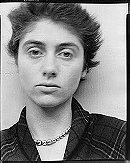
 8.6
8.6
 0
0

